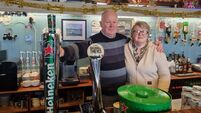Irish ultrarunner Nirbhasa Magee: 'Give me a 3,100-mile race any day over a 24-hour race'

The alarm clock went at 5:37am, right as the sun was beginning its ascent over the New York skyline.
Nirbhasa Magee would pull himself up from his bed and shake himself down, then hop in a car for the short drive to the start line.
He’d arrive at 5:58am, start running at 6, and, with the exception of three 20-minute breaks during the day, the next 18 hours would be spent running: lap after lap of the same 883-metre loop, which, over the course of a long, hot summer, he’d circle 5,649 times. More than 65 miles a day, for seven straight weeks.
Welcome to hell, or heaven, depending on your outlook. The Self-Transcendence 3100-mile is the longest certified road race in the world, taking place each summer in Jamaica, Queens, an area of New York City synonymous with Caribbean immigrants.
Magee, 41, was the first Irishman to complete the race, and since his debut in 2015 he’s gone back twice, finishing second last year. Right around now you might be asking: why? What good reason is there to subject yourself to such slow-roasted torture? The answer is less to do with the body than the mind.
“During the race, your whole sensory intake, your awareness of media, becomes very reduced,” says Magee.
Before we go any further, it’s best to highlight something that’s fundamental to his story: Magee’s birth name is not Nirbhasa, it’s Shane. He grew up in Summerhill, Meath, and spent 15 years in Dublin, where he first moved to study theoretical physics at Trinity. Growing up, he was always more academic than athletic. “I’m not any kind of athlete build. If there was a template for an ordinary guy, I’d be it.”
At Trinity, Magee tried out for the boxing team and a big part of their training was running, which proved an acquired taste. “At the time I hated it and my philosophy was to think as much as possible to distract from the fact you’re out there killing yourself. But now running is part of my meditation.”
He was at school in Kilcock when he was first introduced to meditation and Magee returned to it in his early 20s, joining the Sri Chinmoy Centre in Dublin, which offers free introductory classes. Sri Chinmoy, a spiritual teacher from India, always believed sport and meditation went hand-in-hand.
Magee used to go running with a fellow runner he met at the centre, who encouraged him to try the marathon in 2003.
“That’s when I really started to enjoy (running). I brought meditation techniques in: I’d identify myself with the vastness of nature, the vastness of the sky. Marathons were my thing for 10 years, but I was never particularly good – my best was 3:06.”
How did Shane become Nirbhasa? The latter was a meditation name given to him when he joined Sri Chinmoy and in 2013 Magee had it legally changed. As far as he knows, he’s the only one in the world with that name, which derives from ancient Indian scriptures and means the light that shines from within to do good for the world.
It’s not just what everyone calls him – apart from his parents, to whom he will always be Shane – it’s also a mantra, a chant he repeats every morning. “It’s one thing to say my soul is this inner light that offers good things to the world but a lot of time you don’t feel that. It’s a reality you’re trying to grow into, a reminder of the spiritual side of my being.”
Magee had long been aware of ultra-marathons but until 2012, they were never truly on his radar.
On the way back from a business trip to San Diego that spring, he stopped off in New York to visit the Sri Chinmoy Centre in Queens. While in town he paid a visit to the Self-Transcendence 6- and 10-day Race, organised by the Sri Chinmoy Marathon Team.
“When we pulled up, as soon as I got out, there was this immediate feeling of tremendous peace,” he says. “Something that said: ‘This is something I have to do.’” The next year he came back to give it a try, doing a 24-hour race in London as preparation. “It was torture, I hated it,” says Magee. “Give me a 3100-mile race any day over a 24-hour race.”
In his first crack at the 10-day race he covered 622 miles in total, and despite – or perhaps because of – the overwhelming fatigue, he experienced something he’d never felt before.
By covering more than 600 miles he surpassed the unofficial qualifying mark for the 3100-mile race, and in 2015 he decided to tackle the big one.
“There’s one part that says, ‘Go for it’, and the other is scared silly. I did the (10-day race) again in 2014 and did 702 miles in 10 days, which gave me tremendous confidence I could do the 3100 miles.”
Only 10-15 athletes with appropriate ultra-running credentials are approved to race each year and typically only half will make it to the finish, which requires runners to cover at least 59.6 miles a day for 52 days.
Magee got lucky on his first try. The summer of 2015 was a mild one by New York standards, but even still he struggled to keep pace. “The first 10 days were fine then my miles fell off rapidly, I couldn’t get the energy to get my speed going.”
After 2000 miles he tripped and whacked his head off the concrete, which left a scar over his eye. As he ran on with a bandage, local residents would come up concerned for his safety. That’s the thing about the race: for two months participants are “part of the furniture” in the community.
“You see the same people every day going to work,” says Magee. “You’ve got a ringside view of the whole neighbourhood.”
How did he survive it?
“It was always very important to never think of the whole thing. Sometimes all you want is to get to the next break, then hopefully once you lay down a bit it’s a different race. You need a very good inner feeling for how far you can push it. It becomes a spiritual exercise.
In 2015, he finished seventh in 51 days, 12 hours, and 12 minutes, just under the 52-day cut-off. In 2017 he finished third in 48 days, 16 hours, and 47 minutes.
By this point, Magee had relocated from Ireland to Iceland, pressing pause on his career as a web developer to work as a care assistant in Rejkjavik for a close friend, Snatak Matthiasson, an accomplished distance runner who had developed motor neurone disease.
Matthiasson passed away last year and Magee has remained in Iceland since, where he works in freelance development, taking on projects that match his ethos. Last summer, he returned to New York better prepared than ever for the Self-Transcendence 3100-Mile. The weather, however, made it not just an extremely arduous, but potentially dangerous, pursuit. “One weekend it was the hottest in seven years: 38, 39 degrees with a heat index of 45-46,” he says.
The world record holder, Ashprihanal Aalto of Finland, told Magee he’d be taking an extra break during the day to avoid heat exhaustion, but Magee didn’t want to sacrifice distance. “If I was wise I would have listened. But I ended up running the same miles, 65 to 66 a day.”
That night, he looked up at the shower in his bathroom and couldn’t figure out how to work it. “I was so exhausted,” he says. “When I came back at 6am, the race doctor found out I did these big miles and said, ‘You, be careful.’” But part of the damage had already been done. “Heat exhaustion is a cumulative thing. By 3 or 4pm it’s a very interesting feeling, like a dizziness that comes from just above your stomach, not your head.”
The race doctor insisted he slow down and Magee heeded her advice.
“I’m not interested in pain and killing myself. As long as you listen to yourself and don’t push beyond what your body tries to tell you, then it’s possible to have a happy, healthy race. Tiredness is always going to be a thing, you’re tired all the time, but that’s not really pain.”
On a good night, he was in bed by 1am and would bank four and a half hours of sleep, while during the day his meals were taken on the move. During his three 20-minute breaks, he’d powder his feet and try to lie down for 8-10 minutes.
“Every second, the clock is ticking, so you’re not wasting a second. You become very aware of the value of time. You pull up to the race camp, start walking, get your food, down the hatch, and you’re off again. You’re always eating and you get so sick and tired of it. It’s a struggle to get it down your gob.”
To reduce pressure on his knees, Magee walked around the corners and ran the straights. Aside from the heat exhaustion that set in five weeks into last year’s race, it was a relatively smooth path to the finish, with Magee coming home second to Aalto in a personal best of 48 days, nine hours, four minutes and 57 seconds.

“I evaluate progress in how much time I’ m able to spend meditating on the course. Some people meditate from morning to dusk – I’m not one of those. I have my schedule then I’ll listen to audio books, but every year is my meditation capacity is increasing. It seems to be a deeper feeling every time. It’s less of these cosmic experiences, more a much deeper and more solid feeling, which is better.”
If all was right in the world, Magee would be back in New York this month, circling that same block day after day, week after week. But organisers had no option other than to cancel this year’s race, leaving Magee counting down the months to his next crack. I ask if he has other events on his bucket list, given the wide array of ultra-marathons with far more scenic surroundings, but he has eyes only for this one.
“The race has both the physical challenge and this inner vibration, this feeling we’re helping each other and that we’re all in it together. That, to me, is the ideal of how a race should be run.”
It’s hard for him to articulate, it has brought Magee something he hasn’t found elsewhere.
He thinks of that community of kindred spirits – the support team, race organisers, volunteers – who for two terrific months all pull together with a common goal.
“You see the good side of everybody – people at their absolute best,” he says. “You get hit with so much media about the bad side of humanity and it’s easy to become cynical, but being disconnected from that has a very profound effect. When you spend two months in that environment, you end up with a beautiful view of humanity.”












